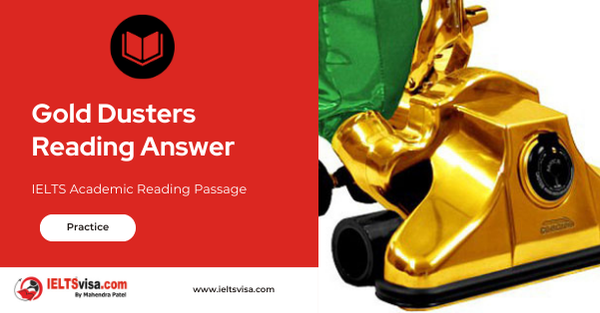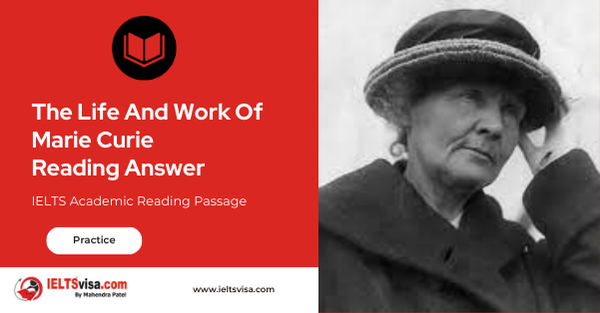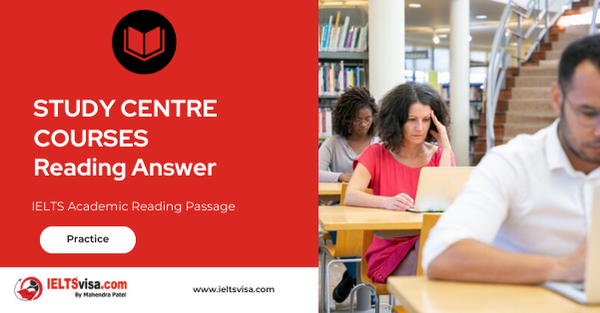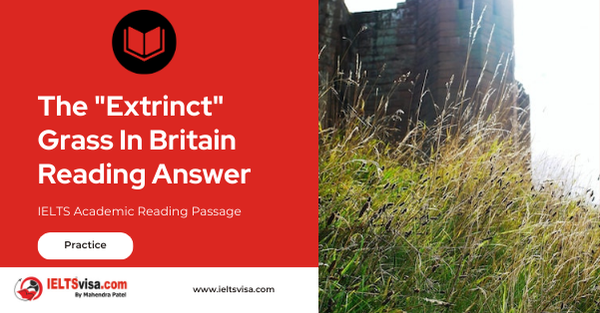Gold Dusters Reading Answer
IELTS Academic Reading Passage
A
Row upon row, tomato plants stand in formation inside a greenhouse. To reproduce, most flowering plants depend on a third party to transfer pollen between their male and female parts. Some require extra encouragement to give up that golden dust. The tomato flower, for example, needs a violent shake, a vibration roughly equivalent to 30 times the pull of Earth’s gravity, explains Arizona entomologist Stephen Buchmann. Growers have tried numerous ways to rattle pollen from tomato blossoms. They have used shaking tables, air blowers and blasts of sound. But natural means seem to work better.
B
It is no surprise that nature’s design works best. What’s astonishing is the array of workers that do it: more than 200,000 individual animal species, by varying strategies, help the world’s 240,000 species of flowering plants make more flowers. Flies and beetles are the original pollinators, going back to when flowering plants first appeared 130 million years ago. As for bees, scientists have identified some 20,000 distinct species so far. Hummingbirds, butterflies, moths, wasps and ants are also up to the job. Even non-flying mammals do their part: sugar-loving opossums, some rainforest monkeys, and lemurs in Madagascar, all with nimble hands that tear open flower stalks and furry coats to which pollen sticks. Most surprising, some lizards, such as geckos, lap up nectar and pollen and then transport the stuff on their faces and feet as they forage onward.
C
All that messy diversity, unfortunately, is not well suited to the monocrops and mega- yields of modern commercial farmers Before farms got so big, says conservation biologist Claire Kremen of the University of California, Berkeley, ‘we didn’t have to manage pollinators. They were all around because of the diverse landscapes. Now you need to bring in an army to get pollination done. The European honeybee was first imported to the US some 400 years ago. Now at least a hundred commercial crops rely almost entirely on managed honeybees, which beekeepers raise and rent out to tend to big farms. And although other species of bees are five to ten times more efficient, on a per-bee basis, at pollinating certain fruits, honeybees have bigger colonies, cover longer distances, and tolerate management and movement better than most insects. They’re not picky – they’ll spend their time on almost any crop. It’s tricky to calculate what their work is truly worth; some economists put it at more than $200 billion globally a year.
D
Industrial-scale farming, however, may be wearing down the system. Honeybees have suffered diseases and parasite infestations for as long as they’ve been managed, but in 2006 came an extreme blow. Around the world, bees began to disappear over the winter in massive numbers. Beekeepers would lift the lid of a hive and be amazed to find only the queen and a few stragglers, the worker bees gone. In the US, a third to half of all hives crashed; some beekeepers reported colony losses near 90 percent. The mysterious culprit was named colony collapse disorder (CCD) and it remains an annual menace – and an enigma.
E
When it first hit, many people, from agronomists to the public, assumed that our slathering of chemicals on agricultural fields was to blame for the mystery. Indeed, says Jeff Pettis of the USDA Bee Research Laboratory, ‘we do find more disease in bees that have been exposed to pesticides, even at low levels.’ But it is likely that CCD involves multiple stressors. Poor nutrition and chemical exposure, for instance, might wear down a bee’s immunities before a virus finishes the insect off. It’s hard to tease apart factors and outcomes, Pettis says. New studies reveal that fungicides – not previously thought toxic to bees – can interfere with microbes that break down pollen in the insects’ guts, affecting nutrient absorption and thus long-term health and longevity. Some findings pointed to viral and fungal pathogens working together. ‘I only wish we had a single agent causing all the declines,’ Pettis says, ’that would make our work much easier!
F
However, habitat loss and alteration, he says, are even more of a menace to pollinators than pathogens. Claire Kremen encourages farmers to cultivate the flora surrounding farmland to help solve habitat problems. ‘You can’t move the farm,’ she says, ‘but you can diversify what grows in its vicinity: along roads, even in tractor yards.’ Planting hedgerows and patches of native flowers that bloom at different times and seeding fields with multiple plant species rather than monocrops ‘not only is better for native pollinators, but it’s just better agriculture,’ she says. Pesticide-free wildflower havens, adds Buchmann, would also bolster populations of useful insects. Fortunately, too, ‘there are far more generalist plants than specialist plants, so there’s a lot of redundancy in pollination,’ Buchmann says. ‘Even if one pollinator drops out, there are often pretty good surrogates left to do the job. The key to keeping our gardens growing strong, he says, is letting that diversity thrive.
G
Take away that variety, and we’ll lose more than honey. ‘We wouldn’t starve,’ says Kremen. ‘But what we eat, and even what we wear pollinators, after all, give us some of our cotton and flax – would be limited to crops whose pollen travels by other means. ‘In a sense,’ she says, ‘our lives would be dictated by the wind. It’s vital that we give pollinators more of what they need and less of what they don’t, and ease the burden on managed bees by letting native animals do their part, say scientists.
H
Build a fast network of guideways in a busy city center and people would have a strong incentive not just to use public Ruf vehicles, but also to buy their own dual- mode vehicle. Commuters could drive onto the guideway, sit back, and read as they are chauffeured into the city. At work they would jump out, leaving their vehicles to park Unlike PRT, such a system could grow organically, as each network would serve a large area around it and people nearby could buy into it. And a dual- mode system might even win the support of car manufacturers, who could easily switch to producing dual-mode vehicles.
I
The RUF system can reduce energy consumption from individual traffic. The main factor is the reduction of air resistance due to the close coupling of vehicles. The energy consumption per Ruf can is reduced to less than 1/3 at 100 km/h. Since RUF is an electric system, renewable sources can be used without problems. A combination of windmills and a RUF rail could be used over water. Solar cells can also be integrated into the system and ensure completely sustainable transportation.
J
Of Course, creating a new transport system will not be cheap or easy. But unlike adding a dedicated bus lane here or extending the underground railway there, an innovative system such as Jensen’s could transform cities. The vehicles in a RUF system rides” very safely on top of a triangular monorail. This means that derailments are impossible and that the users will feel safe because it is easy to understand that when the rail is actually inside the vehicle it is absolutely The special rail brake ensures that braking power is always available even during bad weather. The brake can squeeze as hard against the rail as required in order to bring the vehicle to a safe stop. If a vehicle has to be evacuated, a walkway between the two rails can be used.
K
And it’s not just a matter of saving a few minutes a day. According to the Red Cross, more than 30 million people have died in road accidents in the past century-three times the number killed in the First World War-and the annual death toll is rising. and what’s more the Red Cross believes road accidents will become the third biggest cause of death and disability by 2020, ahead of diseases such as AIDS and tuberculosis. Surely we can find a better way to get around.
Adapted from National Geograptiic Magazine.
Questions 1-7
The reading passage has seven sections, A-G.
Choose the correct heading for each section from the list of headings below.
List of Headings
i Looking for clues
ii Blaming the beekeepers
iii Solutions to a more troublesome issue
iv Discovering a new bee species
v An impossible task for any human
vi The preferred pollinator
vii Plant features designed to suit the pollinator
viii Some obvious and less obvious pollen carriers
ix The undesirable alternative
x An unexpected setback
1 Section A
2 Section B
3 Section C
4 Section D
5 Section E
6 Section F
7 Section G
Questions 8-11
Complete the sentences below.
Choose NO MOKE THAN THREE WORDS from the passage for each answer.
8 Both 8…………………. were the first creatures to pollinate the world’s plants.
9 Monkeys transport pollen on their 9……………..
10 Honeybees are favoured pollinators among bee species partly because they travel 10………………..
11 A feature of CCD is often the loss of all the 11…………………
Questions 12-13
Choose TWO letters, A-E.
Which TWO methods of combating the problems caused by CCD and habitat loss are mentioned in the article?
A using more imported pest controllers
B removing microbes from bees’ stomachs
C cultivating a wide range of flowering plants
D increasing the size of many farms
E placing less reliance on honeybees

Solution for:Gold Dusters Reading Answer
| 1. v | 8. flies and beetles |
| 2. viii | 9. furry coats |
| 3. vi | 10. longer distances |
| 4. x | 11. worker bees |
| 5. i | 12. C OR E IN EITHER ORDER |
| 6. iii | 13. C OR E IN EITHER ORDER |
| 7. ix |
Review and Practice
- Regularly practice with IELTS reading samples and time yourself to get used to the pressure of the exam.
- Review your mistakes to understand where you went wrong and how to avoid similar errors in the future.
Our Books
Master IELTS Speaking Part 1
IELTS Writing Task 1 Book
IELTS Writing Task 2 Book
Gold Dusters Reading Answer Explanation
Comin Soon
Practice IELTS Other Modules
IELTS Listening
The IELTS Listening test assesses how well you can understand spoken English in various contexts. It lasts about 30 minutes and is divided into four sections with a total of 40 questions. The listening tasks become increasingly difficult as the test progresses.
IELTS Academic Reading
The IELTS Academic Reading section assesses your ability to understand and interpret a variety of texts in academic settings. It is designed to evaluate a range of reading skills, including skimming for gist, reading for main ideas, reading for detail, understanding inferences, and recognizing a writer's opinions and arguments.
IELTS Speaking
The IELTS Speaking test assesses your ability to communicate in English on everyday topics. It lasts 11-14 minutes and consists of three parts: introduction, cue card, and a discussion based on the cue card topic.
IELTS General Reading
IELTS General Reading tests your ability to understand and interpret various types of texts. Here are some key areas and types of content you can expect to encounter in the reading section, along with tips for effective preparation.
IELTS Academic Writing Task 1
In IELTS Academic Writing Task 1, you are presented with a visual representation of information, such as graphs, charts, tables, or diagrams, and you are required to summarize, compare, or explain the data in your own words.
IELTS General Writing Task 1
In IELTS General Writing Task 1, you are required to write a letter based on a given situation. The letter can be formal, semi-formal, or informal, depending on the prompt. Here’s a breakdown of the key components to include in your letter
IELTS Academic Writing Task 2
In IELTS Academic Writing Task 2, you are required to write an essay in response to a question or topic. Here’s a guide to help you understand the essential elements of this task
IELTS Exam Tips
To succeed in the IELTS exam, practice regularly, familiarize yourself with the test format, improve your vocabulary, develop time management skills, and take mock tests to build confidence.
Grammer for IELTS
Grammar is the foundation of effective communication in English. Understanding tense usage, subject-verb agreement, and sentence structure enhances clarity and coherence in writing and speaking.
Vocabulary for IELTS
Vocabulary plays a crucial role in the IELTS (International English Language Testing System) exam, especially in the Speaking and Writing sections. Here’s an overview of why vocabulary is important and how it impacts your performance
RECENT IELTS SAMPLES QUESTIONS AND ANSWERS
The Life And work Of Marie Curie Reading Answer
Marie Curie is probably the most famous woman scientist who has ever lived. Born Maria...
Becoming An Expert Reading Answer
A Expertise is commitment coupled with creativity. Specifically, it is the commitment of...
STUDY CENTRE COURSES Reading Answer
SELF-STUDY TIPS AHowever difficult you find it to arrange your time, it will pay off in the...
The Extrinct Grass In Britain Reading Answer
A The British grass interrupted brome was said to be extinct, just like the Dodo. Called...
Morse Code Reading Answer
A. A new satellite-based system is being implemented to replace Morse code for sending...
Magnetic Therapy Reading Answer
AMagnetic therapy, which is a $5-billion market worldwide, is a form of alternative medicine...













